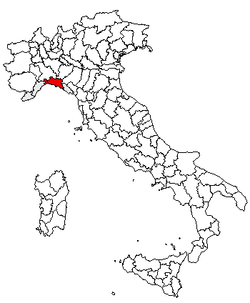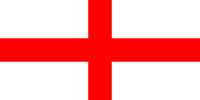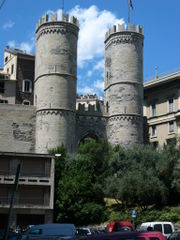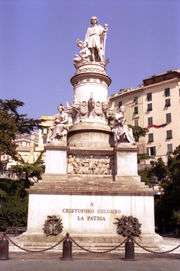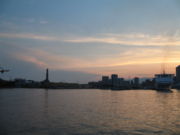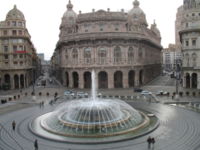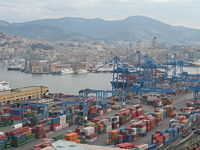Genoa
2008/9 Schools Wikipedia Selection. Related subjects: Europe; European Cities
| Comune di Genova | |||
|
|||
| Coordinates: | |||
|---|---|---|---|
| Sovereign state | Italy | ||
| Region | Liguria | ||
| Province | Province of Genoa | ||
| Government | |||
| - Mayor | Marta Vincenzi | ||
| Area | |||
| - Total | 243 km² (93.8 sq mi) | ||
| Elevation | +20 m (66 ft) | ||
| Population (2006) | |||
| - Total | 620,316 ( 6th) | ||
| - Density | 2,553/km² (6,612.2/sq mi) | ||
| - Called | Genovesi | ||
| Time zone | CET ( UTC+1) | ||
| - Summer ( DST) | CEST ( UTC+2) | ||
| Postal code | 16100 | ||
| Area code(s) | 010 | ||
| Patron saints | St. John the Baptist | ||
| Website: http://www.comune.genova.it/ | |||
Genoa (Genova, pronounced [ˈdʒɛːnova], in Italian; Zena [ˈzeːna] in Genoese; Genua in Latin and, archaically, in English) is a city and an important seaport in northern Italy, the capital of the Province of Genoa and of the region of Liguria. The city has a population of ca. 620,000 and the urban area has a population of ca. 890,000.
Origins of the name
Genua was a city of the ancient Ligurians. Its name is probably Ligurian, meaning "knee", i.e. "angle", from its geographical position, thus akin to the name of Geneva. Or it could derive from the Celtic root genu-, genawa (pl. genowe), meaning "mouth", i.e., estuary, or from the Latin word of Celtic origin "ianua", meaning "door". Part of the old city of Genoa was inscribed on the World Heritage List (UNESCO) in 2006 (see below).
Flag
The flag of Genoa is a St. George's Cross flag, a red cross on a lime white field, identical to the Flag of England, which also incorporates the St. George's Cross.
History
Ancient era and early Middle Ages
Genoa's history goes back to ancient times. The first historically known inhabitants of the area are the Ligures, an Italic tribe. The attribution of its foundation to Celts in 2500–2000 BC has been recently recognized as wrong.
A city cemetery, dating from the 6th and 5th centuries BC, testifies to the occupation of the site by the Greeks, but the fine harbour probably was in use much earlier, perhaps by the Etruscans. It is also probable that the Phoenicians had bases in Genoa, or in the nearby area, since an inscription with an alphabet similar to that used in Tyre has been found.
In the Roman era, Genoa was overshadowed by the powerful Marseille and Vada Sabatia, near modern Savona. Different from other Ligures and Celt settlements of the area, it was allied to Rome through a foedus aequum ("Equal pact") in the course of the Second Punic War. It was therefore destroyed by the Carthaginians in 209 BC. The town was rebuilt and, after the end of the Carthaginian Wars, received municipal rights. The original castrum thenceforth expanded towards the current areas of Santa Maria di Castello and the San Lorenzo promontory. Genoese trades included skins, wood, and honey. Goods were shipped in the mainland up to important cities like Tortona and Piacenza.
After the fall of the Western Roman Empire, Genoa was occupied by the Ostrogoths. After the Gothic War, the Byzantines made it the seat of their vicar. The Lombards submitted it in 643. In 773 the Lombard Kingdom was annexed by the Frank empire; the first Carolingian count of Genoa was Ademarus, who was given the title praefectus civitatis Genuensis. Ademarus died in Corsica while fighting against the Saracens. In this period the Roman walls, destroyed by the Lombards, were rebuilt and extended.
For the following several centuries, Genoa was little more than a small, obscure fishing centre, slowly building its merchant fleet which was to become the leading commercial carrier of the Mediterranean Sea. The town was sacked and burned in 934 by Arab pirates but it was quickly rebuilt.
In the 10th century the city, now part of the Marca Januensis ("Genoese Mark") was under the Obertenghi family, whose first member was Obertus I. Genoa was one of the first cities in Italy to have some citizenship rights granted by local feudataries.
Middle Ages and Renaissance
Before 1100, Genoa emerged as an independent city-state, one of a number of Italian city-states during this period. Nominally, the Holy Roman Emperor was overlord and the Bishop of Genoa was president of the city; however, actual power was wielded by a number of "consuls" annually elected by popular assembly. Genoa was one of the so-called "Maritime Republics" ( Repubbliche Marinare), along with Venice, Pisa, and Amalfi) and trade, shipbuilding and banking helped support one of the largest and most powerful navies in the Mediterranean. The Adorno, Campofregoso, and other smaller merchant families all fought for power in this Republic, as the power of the consuls allowed each family faction to gain wealth and power in the city. The Republic of Genoa extended over modern Liguria and Piedmont, Sardinia, Corsica and had practically complete control of the Tyrrhenian Sea. Through Genoese participation on the Crusades, colonies were established in the Middle East, in the Aegean, in Sicily and Northern Africa. Genoese Crusaders brought home a green glass goblet from the Levant, which Genoese long regarded as the Holy Grail.
The collapse of the Crusader States was offset by Genoa’s alliance with the Byzantine Empire, which opened opportunities of expansion into the Black Sea and Crimea. Internal feuds between the powerful families, the Grimaldi and Fieschi, the Doria, Spinola, and others caused much disruption, but in general the republic was run much as a business affair. In 1218–1220 Genoa was served by the Guelph podestà Rambertino Buvalelli, who probably introduced Occitan literature to the city, which was soon to boast such troubadours as Jacme Grils, Lanfranc Cigala, and Bonifaci Calvo. Genoa's political zenith came with its victory over the Duchy of Pisa at the naval Battle of Meloria (1284), and its persistent rival, Venice, in 1298.
However, this prosperity did not last. The Black Death was imported into Europe in 1349 from the Genoese trading post at Caffa ( Theodosia) in Crimea, on the Black Sea. Following the economic and population collapse, Genoa adopted the Venetian model of government, and was presided over by a doge (see Doge of Genoa). The wars with Venice continued, and the War of Chioggia (1378–1381), ended with a victory for Venice. In 1390 Genoa initiated a crusade against the Barbary pirates with help of the French and laid siege to Mahdia. After a period of French domination from 1394–1409, Genoa came under rule by the Visconti of Milan. Genoa lost Sardinia to Aragon, Corsica to internal revolt and its Middle Eastern colonies to the Ottoman Empire and the Arabs.
Christopher Columbus, a native of Genoa, donated one-tenth of his income from the discovery of the Americas for Spain to the Bank of San Giorgio in Genoa for the relief of taxation on foods. The Spanish connection was reinforced by Andrea Doria, who established a new constitution in 1528, making Genoa a satellite of the Spanish Empire. Under the ensuing economic recovery, many Genoese families amassed tremendous fortunes. At the time of Genoa’s peak in the 16th century, the city attracted many artists, including Rubens, Caravaggio and Van Dyck. The famed architect Galeazzo Alessi (1512–1572) designed many of the city’s splendid palazzi. A number of Genoese Baroque and Rococo artists settled elsewhere and a number of local artists became prominent.
Genoa suffered from French bombardment in 1684, and was occupied by Austria in 1746 during the War of the Austrian Succession. In 1768, Genoa was forced to also cede Corsica to France.
Modern history
With the shift in world economy and trade routes to the New World and away from the Mediterranean, Genoa's political and economic power went into steady decline.
In 1797, under pressure from Napoleon, Genoa became a French protectorate called the Ligurian Republic, which was annexed by France in 1805. This affair is commemorated in the famous first sentence of Tolstoy's War and Peace:
"Well, Prince, so Genoa and Lucca are now just family estates of the Buonapartes.(...) And what do you think of this latest comedy, the coronation at Milan, the comedy of the people of Genoa and Lucca laying their petitions [to be annexed to France] before Monsieur Buonaparte, and Monsieur Buonaparte sitting on a throne and granting the petitions of the nations?" (spoken by a thoroughly anti-Boanapartist Russian aristocrat, soon after the news reached Saint Petersburg).
Although the Genoese revolted against France in 1814 and liberated the city on their own, delegates at the Congress of Vienna sanctioned its incorporation into Piedmont ( Kingdom of Sardinia), thus ending the three century old struggle by the House of Savoy to acquire the city. The king of Piedmont even sent the Bersaglieri to sack the city, defining the Genoese as "scum". The city soon gained a reputation as a hotbed of anti-Savoy republican agitation, although the union with Savoy was economically very beneficial. With the growth of the Risorgimento movement, the Genoese turned their struggles from Giuseppe Mazzini's vision of a local republic into a struggle for a unified Italy under a liberalized Savoy monarchy. In 1860, Giuseppe Garibaldi set out from Genoa with over a thousand volunteers to begin the campaign. This is called the departure of the thousands and a monument is set on the rock where the group departed from.
During World War II the British fleet bombarded Genoa and one bomb fell into the cathedral of San Lorenzo without exploding. It is now available to public viewing on the cathedral premises.
The 27th G8 summit in the city, in July 2001, was overshadowed by violent protests, with one protester, Carlo Giuliani, killed amid accusations of police brutality. Trials of accused officials are ongoing as of 2007. In 2004, the European Union designated Genoa as the European Capital of Culture, along with the French city of Lille.
Main sights
| Genoa: Le Strade Nuove and the system of the Palazzi dei Rolli* | |
|---|---|
| UNESCO World Heritage Site | |
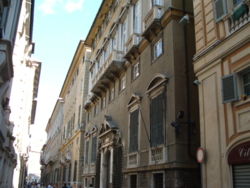 |
|
| State Party | |
| Type | Cultural |
| Criteria | ii, iv |
| Reference | 1211 |
| Region** | Europe and North America |
| Inscription history | |
| Inscription | 2006 (30th Session) |
| * Name as inscribed on World Heritage List. ** Region as classified by UNESCO. |
|
The main features of central Genoa include Piazza de Ferrari, around which are sited the Opera and the Palace of the Doges. There is also a house where Christopher Columbus is said to have been born.
Strada Nuova (now Via Garibaldi), in the old city, was inscribed on the World Heritage List in 2006. This district was designed in the mid-16th century to accommodate Mannerist palaces of the city's most eminent families, including Palazzo Rosso (now a museum), Palazzo Bianco, Palazzo Grimaldi and Palazzo Reale. The famous art college, Musei di Strada Nuova and the Palazzo del Principe are also located on this street.
Other landmarks of the city include St. Lawrence Cathedral (Cattedrale di San Lorenzo), the Old Harbour (Porto Antico), transformed into a mall by architect Renzo Piano, and the famous cemetery of Staglieno, renowned for its monuments and statues. The Museo d'Arte Orientale has one of the largest collections of Oriental art in Europe. The 19th century neo-gothic castle, Castello d'Albertis, once home to explorer Enrico Alberto d'Albertis, now houses the Museum of World Cultures.
Other than the old city sights, Genoa also has a large aquarium located in the above-mentioned old harbour. The Aquarium of Genoa is one of the largest in Europe.
The port of Genoa also contains an ancient lighthouse, called the " Torre della Lanterna" (i.e., "the tower of the lantern"). It is the oldest working lighthouse in the world, one of the five tallest, and the tallest brick one, and it is Genoa's landmark.
Boccadasse is a picturesque neighbourhood in the east side of the city.
Demographics
In 2007, there were 610,887 people residing in Genoa, located in the province of Genoa, Liguria, of whom 47% were male and 53% were female. Minors (children ages 18 and younger) totalled 14.12 percent of the population compared to pensioners who number 26.67 percent. This compares with the Italian average of 18.06 percent (minors) and 19.94 percent (pensioners). The average age of Genoa residents is 47 compared to the Italian average of 42. In the five years between 2002 and 2007, the population of Genoa grew by 1 percent, while Italy as a whole grew by 3.85 percent. The current birth rate of Genoa is 7.49 births per 1,000 inhabitants compared to the Italian average of 9.45 births. Genoa has the lowest birth rate and is the most aged of any large Italian city.
As of 2006, 94.23% of the population was Italian. The largest immigrant group comes the Americas (mostly from Ecuador): 2.76%, other European nations (mostly Albania, and Romania): 1.37%, and North Africa: 0.62%. The city is predominantly Roman Catholic, with small Protestant adherants.
Sports
Football
Genoa Cricket & Football Club gives to the City of Genoa the very first football club founded in Italy. The club was founded in 1893 by James Spensley, an English doctor, and has won 9 championships and a Italy Cup.
Another football club in the city is U.C. Sampdoria, founded in 1946 from the merger of two existing clubs, Andrea Doria (founded in 1895) and Sampierdarenese (founded in 1911). Sampdoria has won one Italian championship, 4 Italy Cups and 1 UEFA Cup Winners' Cup in 1989/90.
Famous people
Famous Genoese include Sinibaldo and Ottobuono Fieschi (Popes Innocent IV and Adrian V) and Pope Benedict XV, navigators Christopher Columbus, Enrico Alberto d'Albertis and Andrea Doria, composers Niccolò Paganini and Michele Novaro, Italian patriots Giuseppe Mazzini and Nino Bixio, writer and translator Fernanda Pivano, poet Edoardo Sanguineti, Communist politician Palmiro Togliatti, architect Renzo Piano, Physics 2002 Nobel Prize winner Riccardo Giacconi, Literature 1975 Nobel Prize winner Eugenio Montale, the royal portraitist Giovanni Maria delle Piane (Il Mulinaretto) from the Delle Piane family, the artist Vanessa Beecroft, comedians Gilberto Govi, Paolo Villaggio, Beppe Grillo, Luca Bizzarri, Paolo Kessisoglu and Maurizio Crozza; singer-songwriters Fabrizio de André and Ivano Fossati, actor Vittorio Gassman, and actress Moana Pozzi, Giorgio Parodi who conceived the motorcycle company Moto Guzzi with Carlo Guzzi and Giovanni Ravelli. Some reports say Giovanni Caboto (John Cabot) is also from Genoa, others say he was from Savona.
Sister cities
 Baltimore, USA
Baltimore, USA Boston, USA
Boston, USA Chios, Greece
Chios, Greece Columbus, USA
Columbus, USA Guayaquil, Ecuador
Guayaquil, Ecuador Huelva, Spain
Huelva, Spain Marseille, France
Marseille, France Odessa, Ukraine
Odessa, Ukraine Rijeka, Croatia
Rijeka, Croatia Saint Petersburg, Russia
Saint Petersburg, Russia


